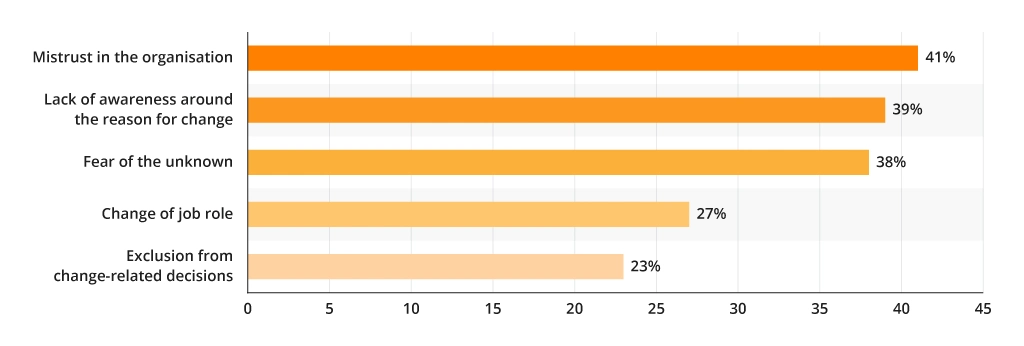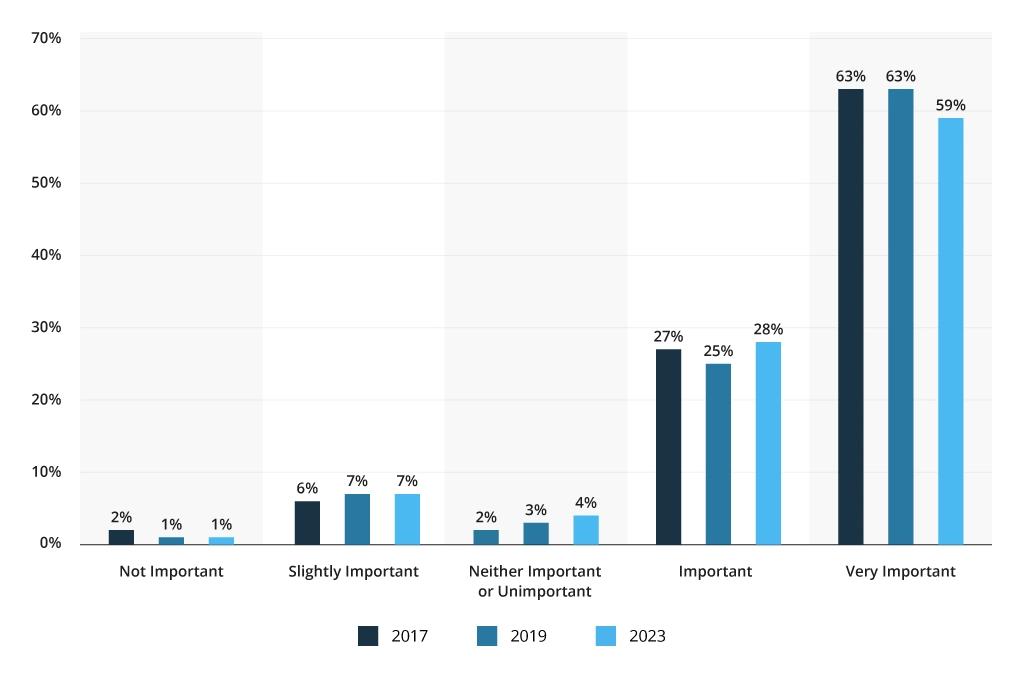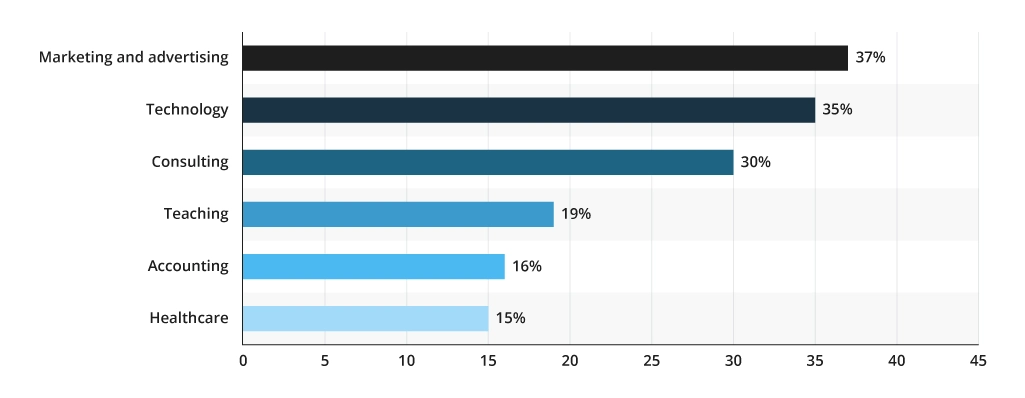Embracing Technology and Adaptability Through Change Management
Amid this backdrop of perpetual transformation, challenges bloom as profusely as opportunities. How does an organization effectively harness the forces of change? How do you approach implementing something as solid and as abstract as change? When executed without a clear roadmap, change initiatives can inadvertently generate resistance and hamper progress.
In such situations, turning to third-party change management experts can be a strategic and valuable decision. A structured approach instils confidence in the organization's leadership and employees, reassuring them that the change process is under expert guidance.
Key Challenges to Incorporating Next-Gen Tech
The integration of new technology is a double-edged sword, as it becomes both a necessity and a challenge. Bringing those advancements into a company’s day-to-day operations introduces profound changes in procedures, culture, and activities. Here are the usual obstacles on the path to innovation that you need to account for.
Resistance to Change
New technology often disrupts established routines and workflows, leading to resistance among employees who are comfortable with existing systems. The fear of the unknown, coupled with concerns about job security and increased workload, can hinder the adoption of new tools. In fact, 38% of employees cite fear of the unknown as their reasoning behind opposing change.
Lack of Skillsets
Implementing and embracing new technology may require a set of skills that employees currently lack. This gap can slow down the adoption process and lead to inefficiencies in utilizing the new tools. According to a report by the World Economic Forum, 60% of workers will require training and reskilling by 2027 to catch up with the changing nature of the workplace.
Integration Complexities
Integrating new technology with existing systems and processes can be complex and time-consuming. Incompatibility issues, data migration challenges, and potential disruptions can pose obstacles to successful implementation, despite businesses’ best wishes to boost digitalization.
Cultural Shifts
New technology often requires a shift in organizational culture to align with its principles and benefits. A long-established culture, an unseen yet a powerful force, might fuel the resistance to change, hindering the adoption of technology-driven practices. That’s why 59% of change management practitioners name cultural awareness a significant driver of successful change implementation.
Sustainability and Scalability
Ensuring the long-term sustainability and scalability of new technology can be a challenge. Factors such as evolving market dynamics, changing business needs, and rapid technological advancements can impact the relevance and effectiveness of adopted solutions.
Robust adoption and change management strategies are pivotal in overcoming these challenges. Bear in mind that driving meaningful outcomes requires meticulous planning and a personal approach. So, here are our recommendations and best practices in leading your company’s transformation initiative to success.
3 Ideas to Fuel Your Successful Transformation
Adopting New Technology = Adopting New Mindset
While the workforce can both drive and fail the transformation, let’s not forget that it takes two to tango, and that sustainable and long-lasting changes demand instrumental change management on a company’s side too. The most common scenario for enterprises turning to transition management consultants is when they have made significant investments in new technology or software, only to find that their employees are not effectively utilizing it.
We are not exaggerating here; sad numbers support this claim. Almost a third, or 29%, of SaaS software spending goes underused or is downright wasted, as highlighted by Flexera's State of ITAM 2022 report.
When a company invests in new technology, it typically does so with the expectation of improved productivity, streamlined processes, or enhanced competitive advantage. However, the success of any technological implementation heavily relies on how well it is embraced by the employees. Often, companies overlook the human element of change and underestimate the impact it can have on their technology initiatives. Supporting a technology implementation with an extensive, clear, and educational dialogue with the employees can turn caution and reluctant engagement into change acceptance and even genuine excitement about new tools and skills that come with it.
According to Prosci's 2021 Best Practices in Change Management report, 80% of respondents put effective communication as the most important contributor to project success. This is rather unobtainable if the executive team has no clear strategy to ground change and ensure commitment.
One of the primary reasons employees may not readily adopt new technology is a natural human resistance to change. Why bother about the benefits of the latest developments, when they are quite comfortable with existing systems? Change management consultants employ various strategies to overcome these resistance factors.
- They conduct thorough assessments to understand the organization's culture, values, and objectives.
- Communicate the rationale behind the technology investment in messages and formats tailored to specific groups of users.
- Emphasize the potential advantages for employees, such as increased efficiency, reduced workload, and strengthened collaboration.
Rightfully and timely employed adoption strategies help cultivate an environment of continuous learning. Through these strategic interventions, change management experts break down the barriers of resistance among employees, boost corporate culture evolution, and foster a genuine embrace of new developments.
Change Management Art: Discovering the Right Approach
Change management methodologies and frameworks vary greatly (you can read about them in this article) and are tied to a company’s unique needs, goals, and challenges. Depending on the novelty that needs to be introduced, community morale, and corporate values, adoption management consultants apply different models and techniques.
Some tools in the change management arsenal:
- Training programs
- Interactive workshops
- Coaching sessions
- Feedback loops
- User forums and collaborative learning
- Knowledge-sharing platforms
- and other secret tactics.
Monitoring and evaluating the progress of technology adoption is another area of change management consultants’ responsibilities. They collect feedback from employees, track usage metrics, and identify any bottlenecks that require further attention. Based on these insights, they refine their agile change strategies and provide recommendations to optimize the implementation process.
Deloitte researchers discovered an enticing correlation between high-performing enterprises and efficient change management. Such companies are 3.5 times more inclined to leverage data for guiding their change initiatives, and an astounding 4 times more likely to seek input from their workers while shaping these transformative changes. So maybe take note of this information.
Case in point. When weighing the possibility of low-code adoption, a leading agriculture company reached Infopulse to test Microsoft Power Apps low-code platform and assess their implementation readiness. Infopulse organized a workshop for the client’s team and showcased Power Apps capabilities with a tailored MVP of a field workers app. As a result, the client committed to a full-scale Power Apps adoption in their organization.
Inward Momentum: All the Power to Power Users
Methodologies, tools, and techniques fuel the adoption process, but you need an initial spark of change. It usually starts from within.
This idea stands behind a change management tactic of Power Users or Change Agents. Power users are individuals within an organization who possess advanced knowledge and skills in using the new technology or software and act as champions or advocates for its adoption.
They are enthusiastic advocates for change and serve as role models for their peers. Once the Power Users are identified, they form a network of Change Agents. This network acts as a support system for each other and encourages a collective effort in driving change. The network can communicate through regular meetings, virtual collaborations, or specialized platforms, fostering a sense of community and collaboration.
Change management consultants identify Change Agents from diverse departments to form a self-perpetuating network of proficient technology users who will disseminate knowledge across the firm. As the organization evolves, the mantra "Change starts from within" becomes a guiding principle that paves the way for future growth and resilience.
The Most Discussed Disruptive Change and What to Do About It
As we discuss underused software licenses and the reluctance to migrate to a new platform, the world is being swept by a next huge wave of change – intimidatingly smart and blazingly quick artificial intelligence. Organizations can either choose to ride this wave of change with finesse or risk being left behind.
Generative AI, exemplified by technologies like ChatGPT, is rapidly transforming the business landscape, with its applications spanning across customer service, content creation, and decision-making processes.
Those intelligent algorithms go beyond manual tasks and are quite adept at writing stories, songs, computer code, and making sales presentations in seconds. According to Gartner's projections, by 2025, an impressive 30% of outbound marketing messages from large organizations will be generated, marking a significant surge from the mere 2% observed in 2022. With even more shocking predictions for the film industry where by 2030, 90% of the content from text to video, will be generated entirely by AI.
The emergence and hasty adoption of AI systems can be likened to a star being born, sending ripples of transformation across industries. With generative AI technologies becoming increasingly prevalent, organizations are facing the urgent need to integrate these systems into their operations.
In this era, where algorithms learn and adapt in real-time, enterprises must navigate the intricacies of change management with precision. The goal is to ease the transition, alleviate resistance, and cultivate a culture where change is not an obstacle, but an opportunity.
Final Thoughts
In this fast-paced era of technology-driven change, enterprises that prioritize adoption and change management strategies are poised to reap the rewards of a successful transition.
As the most-discussed disruptive change on the horizon, generative AI demands a holistic approach. Embracing this transformative technology goes beyond merely adopting new tools; it necessitates a paradigm shift in organizational mindset. Leaders must recognize AI as a powerful ally rather than a replacement, and employees must embrace AI as a partner in their journey towards greater efficiency and innovation.
As the stars of cutting-edge technology align, the organizations that seize this transformative opportunity will be the ones shining the brightest in the galaxy of tomorrow.
![Embrace Technology via Change Management [banner]](https://www.infopulse.com/uploads/media/banner-1920x528-embracing-technology-and-adaptability-through.webp)








![CX with Virtual Assistants in Telecom [thumbnail]](/uploads/media/280x222-how-to-improve-cx-in-telecom-with-virtual-assistants.webp)
![Power Apps Licensing Guide [thumbnail]](/uploads/media/thumbnail-280x222-power-apps-licensing-guide.webp)
![Expanding NOC into Service Monitoring [thumbnail]](/uploads/media/280x222-best-practices-of-expanding-telecom-noc.webp)
![Cloud-Native for Banking [thumbnail]](/uploads/media/cloud-native-solutions-for-banking_280x222.webp)
![Generative AI and Power BI [thumbnail]](/uploads/media/thumbnail-280x222-generative-AI-and-Power-BI-a-powerful.webp)
![Data Governance in Healthcare [thumbnail]](/uploads/media/blog-post-data-governance-in-healthcare_280x222.webp)
![Super Apps Review [thumbnail]](/uploads/media/thumbnail-280x222-introducing-Super-App-a-Better-Approach-to-All-in-One-Experience.webp)
![SAP Service Insight [thumbnail]](/uploads/media/Service Insight-Infopulse-SAP-Vendor-280x222.webp)
